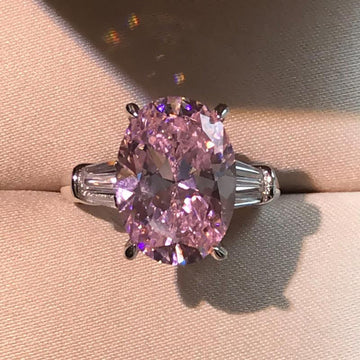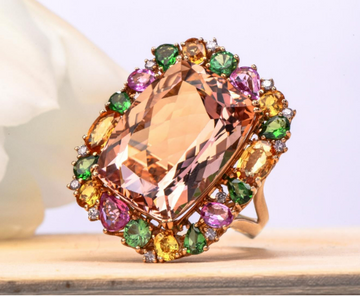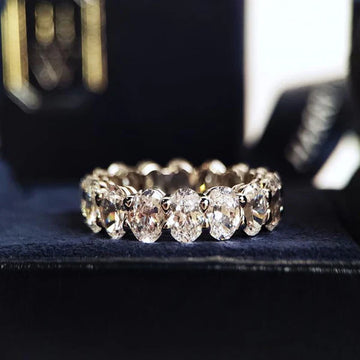The allure of a pink diamond is undeniable. However, with increasing advancements in technology, lab-grown pink diamonds have emerged as a prominent alternative to their natural counterparts. Understanding the key differences between these two options is crucial for making an informed purchase. This blog will break down these differences, provide clear distinctions, and even highlight some potential pitfalls to be aware of.
I. Origin: Where Do They Come From?
-
Natural Pink Diamonds: Formed billions of years ago deep within the Earth’s mantle under extreme pressure and heat. They are brought to the surface through volcanic eruptions. Their pink color arises from structural defects (plastic deformation) in the crystal lattice.
- Clear Distinction: These diamonds are geological marvels, a result of naturally occurring processes spanning eons.
-
Lab-Grown (Synthetic) Pink Diamonds: Created in a laboratory setting using advanced technology that mimics the natural diamond-forming process. Two primary methods are used:
- High-Pressure/High-Temperature (HPHT): Replicates the Earth’s mantle conditions in a controlled environment.
- Chemical Vapor Deposition (CVD): Involves depositing carbon atoms onto a seed crystal in a vacuum chamber.
- Clear Distinction: These diamonds are products of scientific engineering and modern technology.
II. Chemical and Physical Properties: Are They the Same?
-
Natural Pink Diamonds: Composed of pure carbon atoms arranged in a specific crystal structure. Exhibit the same hardness (10 on the Mohs scale), brilliance, fire, and scintillation as other natural diamonds.
- Clear Distinction: Possess inherent natural variations and imperfections (inclusions) that make each one unique.
-
Lab-Grown Pink Diamonds: Possess virtually identical chemical composition, crystal structure, hardness, brilliance, fire, and scintillation as natural diamonds.
- Clear Distinction: While structurally identical, they may lack the unique trace elements and inclusion patterns found in natural diamonds.
III. Rarity and Value: A Significant Divergence
-
Natural Pink Diamonds: Extremely rare, making up a tiny fraction (estimated at 0.0001%) of all diamonds mined. The Argyle mine in Australia, formerly the primary source, closed in 2020, further driving up their value.
- Clear Distinction: Rarity translates directly to high value. Fine quality natural pink diamonds command premium prices and are considered investment-grade gemstones.
- Potential Pitfall: Unscrupulous sellers may attempt to pass off treated or lab-grown diamonds as natural to command higher prices.
-
Lab-Grown Pink Diamonds: More readily available than natural pink diamonds as production can be controlled and scaled up in a laboratory.
- Clear Distinction: Lower scarcity results in a significantly lower price point compared to natural pink diamonds of comparable size, color, and clarity.
- Potential Pitfall: The value of lab-grown diamonds is less stable and more susceptible to market fluctuations as production capacity increases.
IV. Color Origin: How They Get Their Pink Hue
-
Natural Pink Diamonds: Pink coloration arises from structural defects (plastic deformation) in the crystal lattice caused by extreme pressure and heat during formation.
- Clear Distinction: Color is a result of naturally occurring geological processes over millions of years.
-
Lab-Grown Pink Diamonds: Can achieve pink color through two methods:
- Introduction of Nitrogen Vacancies: Defects in the crystal lattice where nitrogen atoms are missing, created during the growth process.
- Post-Growth Irradiation and Annealing: Bombarding the diamond with radiation followed by a heat treatment to create color centers.
- Clear Distinction: Color is achieved through controlled manipulation of the crystal structure during or after the laboratory growth process.
V. Identification: How to Tell Them Apart
-
Natural Pink Diamonds: Experienced gemologists can often identify natural pink diamonds based on their unique inclusion patterns and spectral characteristics.
- Potential Pitfall: Not always possible to definitively identify with the naked eye or standard jeweler’s tools.
-
Lab-Grown Pink Diamonds: Require specialized equipment and expertise for conclusive identification. Gemological laboratories use advanced techniques like:
- DiamondView Imaging: Reveals growth patterns characteristic of lab-grown diamonds.
- Spectroscopy: Analyzes the diamond’s absorption spectrum to detect specific trace elements and defects.
- Clear Distinction: Requires professional gemological testing for definitive identification.
- Potential Pitfall: Some sophisticated lab-grown diamonds are extremely difficult to differentiate from natural diamonds, even with advanced testing.
VI. Ethical and Environmental Considerations:
-
Natural Pink Diamonds: Historically, some diamond mining practices have been associated with environmental damage and human rights concerns.
- Clear Distinction: Ethical sourcing requires careful due diligence and verification of origin.
-
Lab-Grown Pink Diamonds: Often marketed as a more sustainable and ethical alternative due to their controlled production environment and lack of association with traditional mining practices.
- Clear Distinction: Environmental impact depends on the energy sources used to power the laboratory.
- Potential Pitfall: “Greenwashing” claims by some manufacturers require careful scrutiny and verification of sustainability practices.
VII. Disclosure and Certification: Protecting the Consumer
- Natural Pink Diamonds: Should be accompanied by a gemological certificate from a reputable laboratory (GIA, IGI, AGS) that clearly states the diamond is natural and identifies its color grade.
-
Lab-Grown Pink Diamonds: Must be clearly disclosed as lab-grown or synthetic on the gemological certificate. Certification should also include details of the growth method and any post-growth treatments.
- Clear Distinction: Transparency and accurate disclosure are crucial for protecting consumers and ensuring fair market practices.
- Potential Pitfall: Unscrupulous sellers may attempt to misrepresent lab-grown diamonds as natural or fail to disclose post-growth treatments, leading to consumer deception.
Conclusion:
Both lab-grown and natural pink diamonds offer unique advantages, catering to different preferences and priorities. Natural pink diamonds boast unparalleled rarity and a rich history, while lab-grown options provide a more accessible and often ethically compelling alternative. The critical factor is being well-informed, understanding the distinct characteristics of each, and choosing a reputable source that values transparency and accurate disclosure.
Whether you’re drawn to the allure of a natural pink diamond or the accessibility of a lab-grown option, the world of colored gemstones offers a spectrum of beauty and elegance.
Ready to explore a curated collection of exquisite jewelry? At Lyriah, we believe in providing our customers with not only stunning pieces but also the knowledge to make confident and informed decisions.






